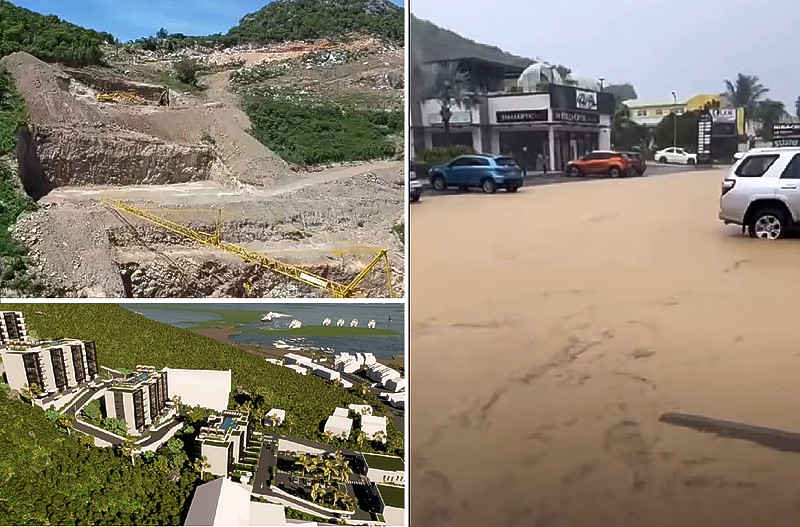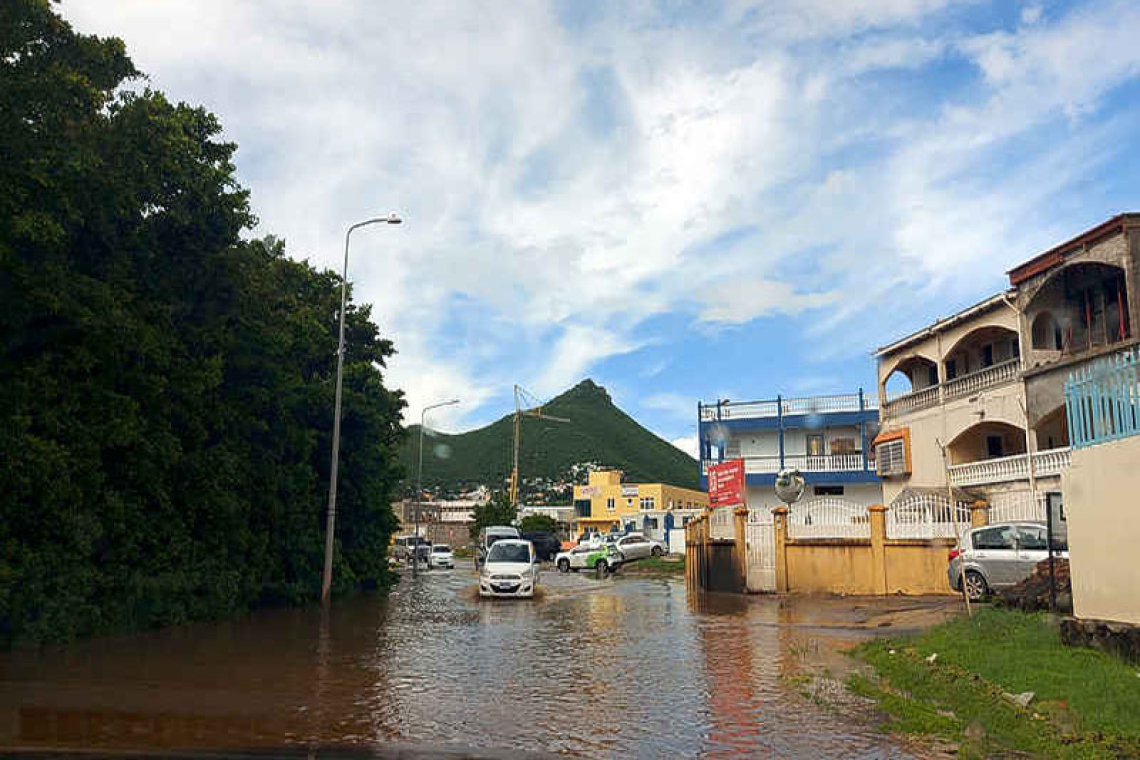Flooding of the roundabout and roads near the St. Maarten Medical Center in Belair on Sunday.
PHILIPSBURG--Minister of Public Housing, Spatial Development, Environment and Infrastructure VROMI Patrice Gumbs addressed on Sunday the impact of ongoing rain showers and flooding on St. Maarten’s infrastructure.
He announced that going forward, tough decisions will be made regarding new construction projects, to enhance resilience and mitigate flood risks.
Extending heartfelt gratitude to all first responders, including the Fire Department, police, and especially VROMI-Yard staff, Gumbs praised their unwavering commitment to public safety and infrastructure management during the past week. He also thanked residents for their patience as clean-up and repairs are underway, recognising that disruptions have affected daily life.

Excavation of the hillside in Cole Bay for The Hills Residences (pictures on the left) has contributed to mudslides onto Welfare Road during the weekend, the VROMI Ministry and environmental organisa-tions claim.
This recent deluge resulted from an unusual atmospheric combination: a cold front – rare for the region – interacted with heavy moisture in the air, leading to intense rainfall. Gumbs said the severity of this event had exposed critical weaknesses in the island’s drainage systems. He emphasised that St. Maarten’s infrastructure has not kept pace with population growth and urban expansion, which increases the risks of flooding, erosion and landslides in high-density areas, particularly in hillside developments.
“The current infrastructure has not grown at the same rate as development has; current drainage is not designed for the high density of buildings or the manner in which we build into the hills, often-times relying on water to just run down the roads, whereas it would naturally soak into the ground,” said Gumbs. He noted that similar sentiments have been expressed for years by the various environmental organisations on the island, as well as the Meteorological Office, as it relates to the infrastructure being able to keep up with changes in climate and weather patterns.
VROMI staff were on the ground around the clock throughout the past week, monitoring water levels in Great Salt Pond and Fresh Pond, crucial reservoirs in the island’s water management system. Emergency efforts commenced around midnight on November 11, as water levels in these ponds reached critical thresholds.
VROMI staff, along with VROMI Secretary-General Kenson Plaisimond and Gumbs, were actively involved in reducing pond levels through controlled drainage, working until 7:00am before proceeding to the official St. Maarten Day events at 8:00am. These teams not only lowered water levels but also provided direct assistance to residents by clearing debris, aiding those trapped in their vehicles and conducting preliminary flood-damage assessments.

Belair from another angle
In particularly flood-prone areas like Ebenezer, Cay Hill, Cole Bay, Pelican/Simpson Bay, and Beacon Hill, VROMI deployed septic trucks to pump out excess water. However, Gumbs said these measures are short-term responses, not permanent solutions to frequent flooding.
“We need a long-term, sustainable strategy,” he said. “Relying on temporary water pumping in flood-prone areas is no longer viable. We cannot continue to address flooding on an emergency basis when these areas experience seasonal rainfall. Residents have voiced concerns for years about drainage and erosion, and it’s clear that meaningful, lasting solutions are urgently needed.”
Responding to misinformation circulating in the community, Gumbs confirmed that floodgates, which release water from Fresh Pond into Great Salt Pond, were indeed opened on November 11. He addressed the functionality of the storm-water pumps, which are essential in directing water from Great Salt Pond to Great Bay via a canal system.
While these pumps were damaged by Hurricane Irma and repaired in July of this year, they suffered a temporary malfunction on Wednesday evening. Gumbs assured the public that the pumps were promptly repaired and back in service by Friday afternoon. During the pump downtime, VROMI opened the Fresh Pond Channel to facilitate water outflow to the sea.
Gumbs explained that in August 2024, inspections revealed that the sheet piles, or metal walls, at the pump site had deteriorated to the point of posing a collapse risk. These structures have reached the end of their lifespan, and their condition affects the pumps’ ability to run efficiently. Using the pumps at high capacity could result in further damage or even loss of the pumps if the platform collapses. This ageing infrastructure limits the efficiency of water management, reinforcing the need for structured maintenance and timely upgrades to critical systems.
Gumbs also addressed criticism that drain cleaning neglect had led to the severe flooding, condemning these claims as outdated and politically motivated.
“This is a played-out, old-school and rather unfortunate attempt by some politicians and their mouthpieces alike to take advantage of a crisis, to the detriment of the population,” Gumbs said. “The awarding of the trench contracts, a decision that I took in August of this year, allowed for a comprehensive cleaning of all waterways for the first time in over three years, which further mitigated the impact that this past week’s flooding could’ve had. Within two months we have managed to tackle many of the larger drains and work is continuing.”
He also voiced his concerns over the recently-completed hard surfacing project, which aimed to pave side roads across the island with concrete. While the project aimed to improve road quality, Gumbs noted that it lacked sufficient drainage planning, which has exacerbated flooding in certain areas. In neighbourhoods like Cole Bay, where the road connections intersect Union Road, this has pushed flooding from the main roads into residential properties, affecting yards and homes.
“We often speak of resilience, but have yet to institutionalise it,” Gumbs said. “The potholes didn’t appear this week, nor did our drainage issues and concerns about how we build and the impact on natural waterways and potential increase for erosion and landslides, as we saw in many areas this week.”
He warned that while rains are ongoing, the VROMI Ministry and other first responders are unable to assist, as they risk putting their lives in danger and potentially making a situation worse.
Gumbs asked the population to exercise caution especially in the use of roadways. “We are all very aware of the state of roads, noting that new potholes emerged with the passing of the rain and many others, already present, have increased in size.” he said. “A large number of these are on roads earmarked for repair, but the amount of rain over the past three weeks has slowed down the rate at which this work is undertaken.”
Gumbs announced that the VROMI Ministry will be making very drastic changes in what will be allowed going forward where it pertains to development. While this may mean that in cases of both private and public land people will not be able to build as they wish, the limitation and potential increased cost of building are outweighed by the safety, quality and peace of mind it will bring to the population as a whole.
The impact of the current heavy rain on homes, infrastructure and the economy is testament to the fact that tough choices have to be made, Gumbs concluded. “These won’t be popular decisions, but they will be the right ones.”







